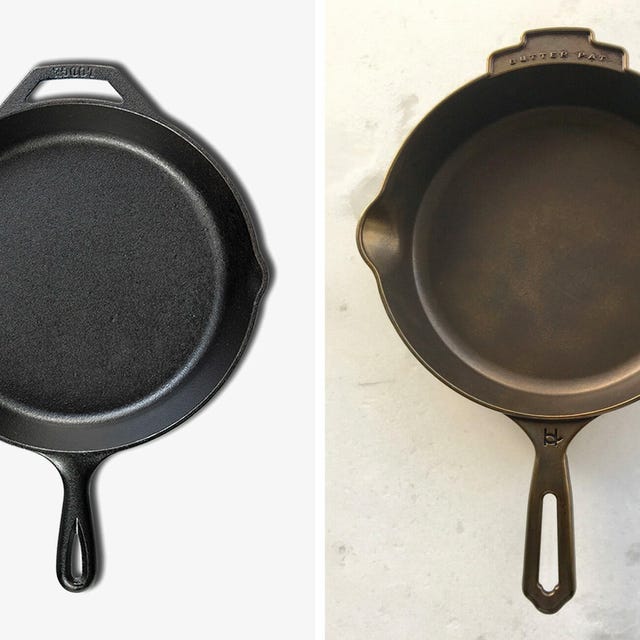New cooks can be intimidated by cast-iron cookware’s need for seasoning, the age-old “soap or no soap?” cleaning question and the seemingly infinite crackpot cast iron “hacks.” Fundamentally, cast-iron skillets are heavy, brittle, sear machines with a reputation for fussiness. So why would you buy a $200 version of a pan — like Butter Pat’s Heather skillet — instead of a $20 version, like Lodge’s popular 10.25-inch skillet? Here’s what you need to know to decide for yourself.
Lodge Skillet: $20 | Butter Pat Skillet: $215
Cooking Surface
The most apparent difference between the Butter Pat and the Lodge — and between most new-era, premium cast-iron skillets and Lodge — is the cooking surface. Lodge’s skillets are rough and feel like heavy metal sandpaper to the touch, a texture created by sand-based machine casting and no finishing process. Butter Pat’s skillets — and those from Smithey, Field Company, Stargazer and Lodge’s own Finex — are smooth, but not all for the same reason.
Pieces from the likes of Finex or Smithey are sand cast but machined (often by lathes) into a silky smooth cooking surface. Butter Pat’s, however, is cast smooth and thin by hand. The details of this process are proprietary, but, according to its website and company founder and lead designer Dennis Powell, are based on manuals and guides from the 1800s, when cast iron was king.
Functionally, the smooth surface affords an immediate near-non-stick cooking experience. Delicate foods like eggs or fish are far less likely to stick on a less porous surface. The want for a smooth surface is strong enough to have spawned dozens of hugely popular Youtube tutorials on the subject of sanding your Lodge (or other comparable, frugal choice) to a smooth finish. There is a ripple effect that comes with a smooth cooking surface versus a rough one. Consider…
Ease of Cleaning and Seasoning
A smooth surface releases hardened and stuck food particles more easily than a porous one, and though smooth-cast and machine-cast skillets are not perfectly smooth (there are microscopic dips and holes even in seemingly smooth iron), they certainly let go of food with less of a fuss. This goes for both cleaning and cooking — smooth cooking surfaces are less prone to grabbing ahold of cold chicken skin than the rougher Lodge.
Many, like Powell at Butter Pat, also suggest seasoning comes to a smooth skillet significantly easier than a rough one, citing vintage skillets’ smooth surfaces as an example. There was very little to no mention of seasoning processes as we know them today in cast iron’s heyday — home cooks of the day opted for a “grease it up and cook” style.
Weight (Mass)
More than any other feature, mass is what separates cast-iron cookware from its stainless steel, carbon steel, aluminum and copper counterparts. Its incredible mass grants it unchallenged heat capacity — sometimes called heat retention, or the ability to remain hot as shit after food is placed in it — and more even heating. For cast-iron cookware nuts, mass is a hotly debated subject.
The modern Lodge 10.25-inch skillet weighs 5.35 pounds, while Butter Pat’s Heather skillet comes in at 4.8 pounds. The half-pound difference isn’t a surprise — Butter Pat’s skillets are cast with extremely thin walls, like the cast-iron skillets of old, while new Lodges are rather chunky comparatively, the result of mass production.
From a cooking perspective, the change is insignificant — both skillets, once properly heated, will climb and stay at high temperatures, even when confronted with the thickest and coldest of steaks. Pragmatically, half a pound less strain while tilting the pan for a baste, tossing vegetables or lifting a pie from the oven is noticeable.
That said, both are leagues heavier than skillets of the same size made of different materials. All-Clad’s category-leading clad stainless steel skillet weighs 3.5 pounds, while de Buyer’s famed carbon steel skillet is 3.8 pounds. Copper and aluminum cookware are lighter still. When comparing cast-iron skillets, lighter is typically considered better, even if only from a convenience standpoint; when comparing cast-iron skillets to skillets made of other stuff, the weight is its moneymaker and the reason we still cook with them.
Verdict
Unsure about this whole cast-iron skillet thing? Get a Lodge. The investment is low and it demonstrates the base functions of cast-iron skillet cooking as well as the pricier Butter Pat (or similar, modern era cast-iron cookware makers). Butter Pat’s skillets will take to seasoning better, release food more easily and, thanks to its small-batch hand casting process, are lighter and easier to tool around with on a stove or over a campfire, but they don’t boast inherent advantages in the capacity to sear food.
Lodge Skillet: $20 | Butter Pat Skillet: $215
Note: Purchasing products through our links may earn us a portion of the sale, which supports our editorial team’s mission. Learn more here.


















